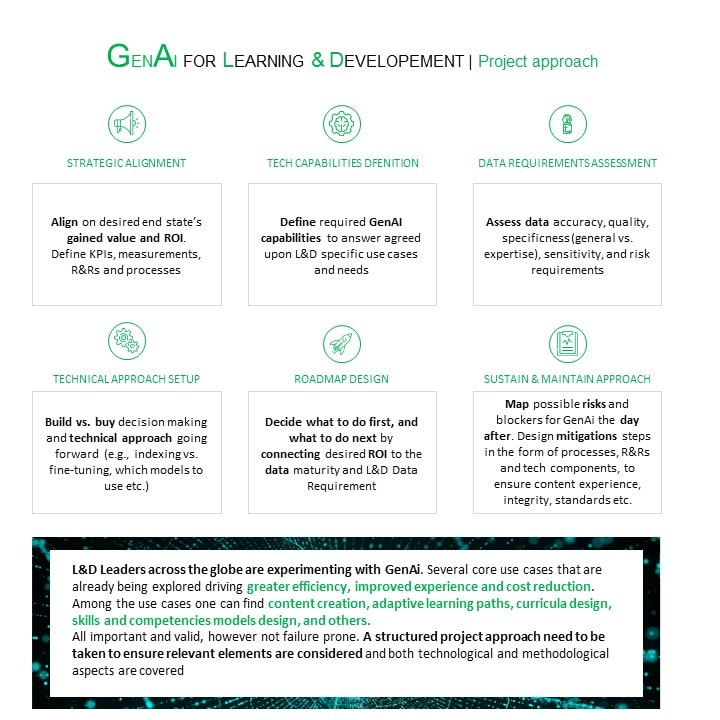GenAI Shuffles L&D’s Cards has been saved

Article
GenAI Shuffles L&D’s Cards
Expectations are shifting, organizations are trying to keep pace
GenAI had shuffled the cards. It changed the way we interact with technology as well as the way we expect it to serve us. Whether it is anyone of us mastering our prompts to get crisp answers to our questions / generate images, up to organizations embedding GenAI as part of their tech stack to gear greater efficiency; GenAI is everywhere.
As expectations shifted, organizations cannot afford themselves to leg behind. According to Gartner’s latest publications (1) increasing number of organizations are planning to implement generative AI in the immediate future: by 2025 it is expected that 50% of new content generation will be produced using GenAI and 35% of large organizations will have named a Chief AI officer reporting to a CEO or COO. Moreover, by 2026, it is expected that more than 100 million people will engage robo-colleagues (synthetic virtual colleagues) to contribute to enterprise work.
However, the Generative Intelligence revolution caught some organizations off-guard (2) as they struggle with lack of HR AI and GenAI strategy, unsupportive organizational culture & leadership, incompatible processes, or shortage of relevant skills to be able to leverage GenAI to its full. Not to mention risk averse nature of many that demonstrate concerns around GenAI’s inaccuracy, inherited bias, or insufficient Machine Learning/GenAI training due to insufficient “real world” data in big scales.
What does it mean for L&D?
So why do more and more organizations embark on a journey of implementing GenAI as part of their ongoing operations, and more specifically, as part of their learning and development efforts? the simple answers is that many organizations today focus on ensuring business continuity and resiliency by boosting their human factor. Getting a bit more granular, there are 5 key drivers that we have identified to push organizations towards implementing GenAI in the L&D area:
1. Increase efficiency and productivity - by leveraging creative content generation organizations can spend less time on knowledge retrieval, instructional design, content & syllabus development, knowledge curation, ad-hoc (non-structured) people analytics etc. Tasks that traditionally take from several hours to several weeks can now take significantly less time, freeing professionals to deal with more complex situations and drive more innovative solutions. Also meaning – shorter time to market.
2. Drive higher ROI – not only that delivery time can be shortened, leveraging generative modules to predict L&D initiatives with high ROI, ensure professionals keep their eyes on the ball. Focusing on intiatives that can shift the needle, instead of embarking on journeys that may not yeild desired outcomes.
3. Support business continuity - addressing GenAI as employee’s enhanced extension, adds required sets of critical capabilities to the workforce. Having the right mix of GenAI and human capabilities can boost workforce competencies and promote high-performing individuals and teams, gaining nimbleness in answering constant market shifts.
4. Provide positive & personalized workforce experience – personalization and innovation are the trader’s currency when gearing towards more engaged and connected employees. Harnessing generative models as part of organizations’ efforts to better understand employees’ preferences generates personalized recommendations across various L&D areas as part of the overall employee experience. Also, living up to employees’ expectations of leveraging innovative tools as part of their day-to-day.
5. Enable DEI & DEI experience – harnessing GenAI’s creative content generation as a live content transformation capability is a DEI game changer. The ability to transform and streamline adjusted content, according to employees’ specific needs at the relevant situation, provides an inclusive environment of work. Also, leveraging generative modules to design skills taxonomies, maps and match candidate / employees to jobs and roles based on their skills, eliminates inherent bias that is incorporated in traditional talent acquisition and internal mobility processes.
Putting the right foundations in place
GenAI implementation efforts are not failure prone. Mitigating potential GenAI related risks such as content integrity, bias, IP and confidentiality, and even the risk of simply being generic or irrelevant, a structured project approach must take place, and the right knowledge and skills must be harnessed.
Looking at GenAI projects, a structured framework is critical to ensure relevant elements are considered, covering both technological and methodological aspects. Such GenAI projects need to look into 6 key elements: Strategic alignment, Tech capabilities definition, Data requirement assessment, Technical approach and setup, Roadmap design and Sustains & maintain approach (see image).
Having the right skills to get the most out of GenAI
Nevertheless, the human factor of knowledge and skills is important just as much as the technology. Whether the focus is L&D professionals leveraging GenAI, or L&Ds role in upskilling employees, success lays with being properly skilled to work with GenAI, and have good enough understanding of how to best utilize it. That means organizations must equip their employees with answers to 3 key questions: How GenAI works, How should it be approached and How to best leverage it as part of ongoing work; while supporting them in further developing their human capabilities of critical thinking, problem-solving, decision making, adaptability, creativity, integrity etc.
L&D’s role is reshaping, again
Looping back to organizational resiliency that is based on the human factor; GenAI related and impacted skills must be factored as part of L&D’s strategic direction. Keeping in mind the tech capabilities that form augmented teams with “robo-colleagues”.
This exciting journey towards GenAI for L&D had only begun, yet to fully uncover what is ahead. Reshaping, once again, L&D’s role as business partners that generate value and drive ROI.
One thing is sure though – putting the right foundations is key for organizations and L&D professionals to stay ahead of the curve, and even remain relevant...

(1) Gartner, July 2023
(2) Source: Deloitte's 5th Annual Artificial Intelligence Report (2020), n = 2,620.
Recommendations
Digital Strategy
Become an intuitive enterprise: sense and shape markets
Navigating Latin American shared services opportunities
A market-by-market guide



